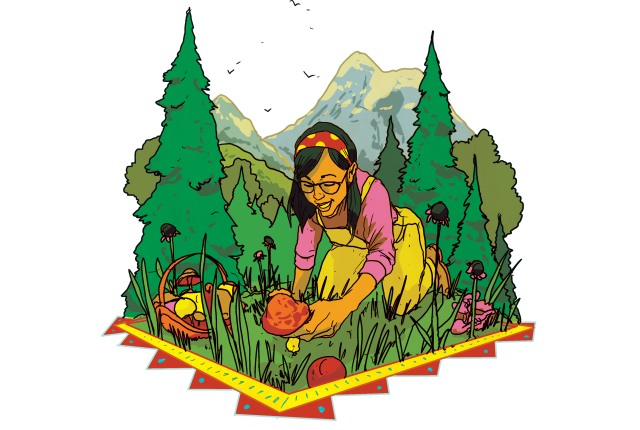TAKE A WALK IN ANY DIRECTION with a couple of skilled foragers, and a weed will never look the same again. Up a mountain trail, down a sandy arroyo, and even in your own backyard, it’s astonishing to discover the feast you can find in the wild.
Six years ago, Cebastien Rose and Robin Moore founded the Albuquerque-based company Dryland Wilds. Their aim was to practice and teach sustainable wildcrafting while creating desert perfume, botanical balms, and other products infused with what they call “the desert’s real scents of place.” One late summer day, they travel from the South Valley to my Santa Fe backyard, overgrown from monsoon rains with plants I’ve never seen before, to demonstrate what foraging in the desert looks like.
“This is called pigweed because farmers fed it to their pigs. But it’s also called amaranth, which you can harvest in the fall for grain,” says Rose, as she plucks a stalk from a green plant I had written off as a pesky weed. “It’s a superfood, and you can eat the greens, which are more nutritious when cooked.” She explains how to tell when amaranth is ready to harvest by tapping the plant to see if its seeds drop out, and how important this plant was to the ancient Aztecs.
Moore, Rose’s wife, has meanwhile found some Russian thistle, also known as tumbleweed. It turns out this reviled “weed” belongs to the spinach family. Although a bane when it grows older, its greens are edible when young, along with the seeds. Breaking off a twig from a piñon tree, Rose says it’s a cinch to drop it in a coffee pot while the water’s brewing, or in tea water for five minutes, to infuse a morning drink with pineapple and caramel notes from the wood and the needles.
Rose and Moore are steeped in botanical knowledge, which they happily share in seasonal workshops, or what they call Wild Walks. In these sessions, attendees learn about useful plants and ways to sustainably harvest and process them in places like Santa Fe’s high desert and Albuquerque’s bustling cityscape.
“It’s really fun to walk past the ornamental trees in your neighborhood and realize they have so many edibles—they’re like a grocery store,” Rose says. “We found that once you start learning about a plant, what role it plays in its own community, you’ll never take a walk in the same way.”
Rose and Moore only teach about invasive and common plants, leaving rare species to the wilderness and sacred plants to Native people. For their products, they work primarily with ranchers, harvesting invasive flowers from throughout the state. Their work helps restore healthy ecosystems by eliminating herbicides ranchers might otherwise use, and also by decreasing the number of invasive seeds from those plants.
Their wearable scents are made with foraged ingredients such as tumbleweed, piñon, snakeweed, and sage. A few soothing drops of Rosehip + Thistle Beauty Oil on the skin, for instance, release an aromatic blend of piney forest, fruity rose hips, and musky nodding-thistle notes. Cliffrose Perfume, crafted following a rare chance to prune flood-damaged wild roses in bloom, took three years to make and then quickly sold out.
Each product reflects the season and the place where the plant was harvested. New Mexico’s diverse wilds provide year-round foraging. The fall selection includes prickly pear, musk thistle roots, honey locust pods, piñon nuts, Russian olive berries, and rose hips. Winter brings piñon needles, Siberian elm inner bark, and winter wild mustards, followed by spring’s Russian olive flowers, Siberian elm samaras, and baby tumbleweed. Summer’s bounty includes cholla buds, quelites, sweet clover, chokecherries, and honey mesquite pods.
Foraging by location makes a difference, although there’s crossover. The Taos area includes mullein, wild plum, and sumac. In Santa Fe, you’ll find juniper berries, cholla, and mushrooms. An Albuquerque forage yields Russian olives, honey locust, and cholla. Las Cruces offers prickly pear, honey mesquite, and sumac.
Back in Santa Fe, as Rose and Moore get ready to leave, they point out snakeweed in my driveway, with its bright yellow flowers that can relieve arthritis when added to bathwater. I wave goodbye, then open a sample they left me of Juniper Soliflore, a perfume made from the tree.
Breathing in the rich scent, I’m transported to a New Mexico forest, fragrant from the summer sun’s warmth on each pine needle. I can’t wait to get back to foraging.



